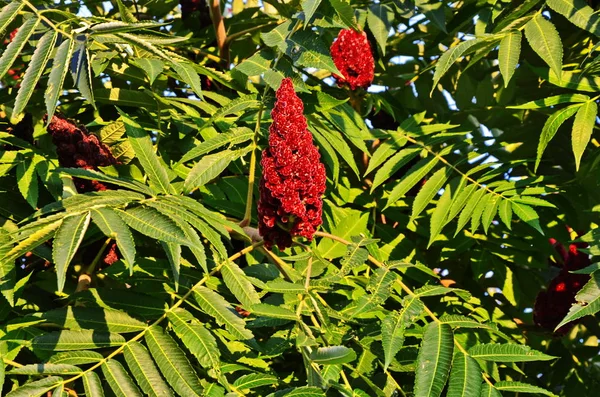What?! You want me to eat poison?
Growing up in central Illinois, I am very familiar with Sumac. The sumac growing in central Illinois was Toxicodendron vernix, commonly known as poison sumac. I avoided this bush or small tree because all parts of it have urushiol-containing resin. Urushiol is the chemical that causes poison ivy irritation. Even though this plant is dangerous to humans, birds eat its creamy white fruit. So, imagine my surprise when I read about a recipe that included sumac as a spice!
A Tale of Two Sumacs
The only useful purpose I knew for poison sumac was that it could produce an attractive dye. When I was young, many artisans would extract the dye from all parts of the plants. I always thought this sounded very risky. However, the rich burgundy color was worth it. I couldn’t believe anyone would willingly eat poison sumac.
But as it turns out there’s another sumac used as a source for a spice. You tell the difference between the two by the color of their berries. Poison sumac has clusters of white berries that sag downward on its branches and the edible sumac’s berries are red and stay upright.


Separating the Sumacs
When I saw a dish with sumac as a spice, I had to try it. Researching edible sumac, I discovered it’s used in the Mediterranean area to add tartness to a dish. Its acidity helps cut through the richness of the lamb. I agree it imparted a lovely flavor to the dish I tried. It was sort of lemony, slightly tart, but with a hint of sweetness. Very refreshing. I’ll definitely have it again.
The spice sumac is in the Rhus genus, making them distant cousins of cashews and mangoes, two more of my favorite foods. They are deciduous shrubs or trees that grow in temperate and subtropical climates around the world, with leaves that change colors during the fall season. Even though there are over 150 species in the Rhus genus, two species are the most commonly consumed, Rhus coriaria and Rhus typhina.
R. coriaria berries are dried and ground to produce powdered sumac. This species originated in the Mediterranean region and then spread across southern Europe and the Middle East. R.typhina is found in North America. Several other species are also found throughout the continent, each with their own distinct characteristics. Some fruits are used to create the drink sumacade, while other young sprouts are eaten in salads.
Fragrant sumac, R. aromatica, is the least common of the consumed North American sumacs. It has a strong lemon scent and the tart berries are used to create beverages as well as being a source of dye and tobacco flavoring for Native Americans.
Using sumac for dyes and tanning started in ancient Greek and Roman societies, similarly for both the edible and poisonous sumac varieties.
Knowing the difference between edible and poisonous plants is an important part of education. Many toxic plants look similar to edible and desirable plants. Besides learning about the plants in your neighborhood, you can also learn some interesting history. I never thought a recipe would lead from the poison sumac of my childhood to Mediterranean cooking to Native Americans and ancient history!
If you or someone you know is interested in learning more about interesting plant life (ever heard of the Headache plant?), take a peek at my STEM workbooks!
To learn about our latest science-based children’s books and workbooks, to read our latest blog posts about reptiles, birds, cats, and gardening, in a variety of locations, and about how the books come to be, what inspires an author to write, and many more interesting aspects of the publishing business, fill in the box below and we will add you to our email list.
Thank you!



